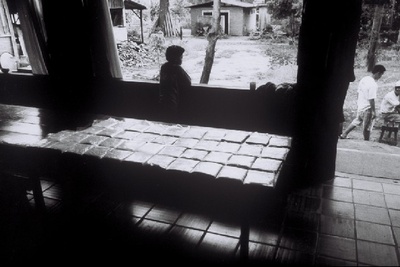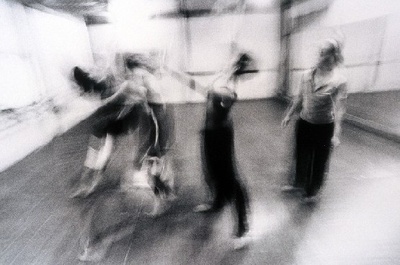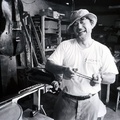At Yama, where farming, daily reverence, and art converge, the idea of work can mean most anything. The people grow fruits and vegetables, raise poultry and dairy cattle, cultivate shiitake mushrooms, roast coffee, produce butter and cheese, and ferment soybeans for miso and soy sauce. The weekly schedule revolves around adult and youth ballet, chorus, Japanese language lessons, and studio art for the young.
Worn footpaths go off in all directions on the farm and one may wander freely around: orchards, vegetable garden, dairy cow barn, packing shed, old silkworm shelter where mushrooms now sprout, tool shed, amphitheater, chicken coops, pig pens, laundry tubs and adjoining drying area strung with barbed wire, library, guest house, sculpture garden, tennis court, swimming pool, atelier, ballet studio, string instrument workshop, wood fired climbing kiln. No matter where one goes, all paths lead back to the cozinha.
The communal dining hall is more like a large picnic shelter. Wind and rain blow in through this open-air structure across weathered wooden tables and benches. Food is served buffet style and the kitchen crew sounds an animal horn to signal meal times. The center of life for Yama is this kitchen. All life breathes through here. Some community members, especially the young, spend more time here than in their own homes. Cozinha is a place to: welcome guests, watch baseball on television, fold laundry, get a hair cut, nurse a baby, practice the piano, make a phone call from the only telephone, display the children’s artwork, hang letters and photographs sent from friends around the world, discuss the weather. On some nights, tables are moved aside for chorus practice or rearranged in a square for a group read-through by those with parts in the annual Christmas production. It is also a place for observing expressions and noting absences.
In the early days of immigrant life, Japanese preserved memories of their homeland by retaining Japanese customs and practices. Yama’s calendar reflects both Japanese and Brazilian festivals. Both cultures guide the selection of menus, and mangos and guavas sit alongside tofu and pickled plums. The yearly rhythm reflects old Japanese ways of life: pounding mochi or sticky rice for the New Year, evening baths at a communal bathhouse, Boy’s Day carp streamers, Milky Way wishes at Star Festival time, pickling and drying of Japanese vegetables, rolling sushi for festivals, writing of haiku.
The community’s ties with Japan are undeniably strong. Relatives and friends come from halfway across the globe to visit. Videos, books, and clothing sent from Japan are eagerly received; however, the warm ties with what was once considered a nostalgic homeland have become a contractual bond of recruitment and opportunity. Brazil’s economic hardships have created a reverse migration of third and fourth generation Japanese-Brazilians seeking employment in Japan’s migrant labor force. They can earn more money than many professionals in Brazil by taking on “three-K” jobs no one wants in Japan. These are jobs known to be kiken, kitsui, kitanai, or dangerous, difficult, and dirty.
To outsiders it is known as Community Yuba. For numerous Japanese travelers who make their way to South America it has become a Mecca. The farm has a simple rule of hospitality. Whether wanderer, dreamer, or vagabond, one can stay for as long as one likes. In return for room and board, visitors are asked to help with various chores, which range from harvesting fruit to kitchen duty to repairing buildings. People from around the world visit Yuba. Weary travelers make their way to the farm, either as a planned point of destination or having stumbled on the name from a passing fellow nomad. Some rest for a few days before moving on. Others stay for months at a time, and there are a few who marry into the community and accept its ideals.
Over the years Japanese visitors and even one notable novelist have written about Community Yuba. In diaries, letters written home and magazine articles, those from outside the community have felt a strong impulse to record impressions. There is almost nothing that exists in English except for a poem “Song of Rejoice,” written in 1998 by a Japanese traveler. His rough English translation has been slightly reworked below. This narrative is now an integral part of the Yuba theater repertoire. The “I” in the poem is the farm’s ballet instructor and main choreographer, Akiko Ohara. Invited by Isamu Yuba to join the farm with her sculptor husband in 1961, Akiko has made Yama her home for the last forty years. Sasamori wrote this poem to describe her rapture and delight. Akiko’s moving recitation of this poem in Japanese opens a musical number that depicts the early history of the community in song and dance.
Song of Rejoice
by Tetsuyuki Sasamori
Brazil is a country 23 times larger than Japan.
One million and four hundred thousand Japanese and their descendants are now living here.
And 1998 is the 90th anniversary of Japanese immigration.
Isamu Yuba, he came from Japan in 1926 in search of a free world.
He was only 19 years old, when he swore that in this land he would build a new culture.
He raised his axe to clear the virgin forest.
Soon many fellow countrymen came to join him
-to form a bond with the land,
-to pray and find peace,
-to dedicate themselves to art.
Thanks to the united spirit among the young idealists, Yuba’s farm was born. As time went by, the group grew to a couple of hundred.
I left Japan 39 years ago. I came along with the sculptor Hisao Ohara to live on Yuba’s farm. On the way, 600 km to the northwest of Sao Paulo city, I was amazed by the size of the horizon to which you could lose sight in every direction. And the highway seemed to cross the sky until finally a red dirt track took us to Yuba’s farm.
Brown faces, all wrinkled by the sun. Rough hands. Grey hair – white beards!!
I saw people with big grins revealing toothless mouths:
Kind faces, sharp eyes...
The children that I found there seemed to have just sprouted from the ground.
They’d merrily play, soiling themselves all over in the mud.
I was also surprised to see girls working under the blazing sun, plowing, harvesting the rice, talking and singing in high voices.
At night, as the enormous sun disappeared behind the horizon, an immense sky full of shining stars would emerge.
I found myself deeply involved. I felt like living again, understanding the true value of human life.
Isamu Yuba, he was a real pioneer and a creative man.
On the earth cultivated by our parents so that their descendants would be proud to live and carry this same pioneering spirit. That was his prayer as an old pioneer.
This man who has passed away rests in the heart of this earth leaving behind his wishes for us:
-to live with the land
-to pray
-to practice art.
This ideal of Isamu Yuba is kept alive in the soil of this country.
The young men vigorously lift their axes under the blazing sun.
And the children play and soil themselves cheerfully in this red earth.
© 2004 Janet Ikeda







